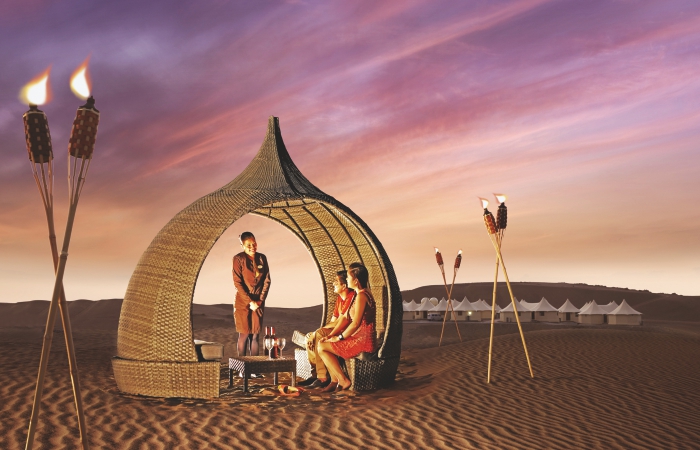If you have been waiting to experience the delights of the Arabian Nights, visit Oman. Distinctively Arab in its outlook, the country will not only fulfill your fantasies, but you will also come away relishing the entire experience, as tradition and modernity go hand in hand in many aspects of Omanis’ lives.
Starlit dinners, sea, sand, and not a cloud in sight! Uninterrupted sunshine bathes a unique blend of magnificent Arabian heritage. And welcoming one is tradition, hospitality, discovery and adventure.
If you have been waiting to experience the delights of the Arabian Nights, just cast a glance at Oman. Not only will it fulfill your fantasies, but you will also come away relishing the entire experience.
Tradition and modernity go hand in hand in many aspects of Omanis’ lives, making the country a land apart, where contemporary life meets timeless desert.
Once a thriving, strategically located port of the Arabian Peninsula, Muscat, the capital of Oman, today ranks among the world’s best-planned and cleanest cities, yet remains a cradle of culture tucked away in the folds of tradition, presenting a blend of the old and the new. It is this stark contrast of lifestyles, existing alongside one another, that makes the country a fascinating tourist destination.
The Oman Government’s idea is to preserve local heritage and culture amid progress. They are constantly moving forward and transforming. The country’s location is another big plus point. The country has an eye on the desert and the sea, both of which facilitated trade and also created a rich heritage, right from early days.
Muscat typifies this well. For a taste of genuine local flavour, visit Muttarah, a busy commercial centre renowned for its cornice, girdle-shaped promenade, bay and harbour with romantic old dhows, visiting cruise ships and naval vessels. Lining the promenade are offices, shops, cafes, trading houses and souks, notably the Muttarah Souk with some shops the size of a small lounge, others no bigger than a walk-in closet. Meander through the maze of this market souk with its seemingly endless corridors of little shops, wade through stalls of vegetables and dates, and see the day’s catch on display in the busy fish souk. Incense smell prevails. The same atmosphere pervades Souq Al Juma, popularly known as Friday Market.
Bargain and enjoy yourself. Munch on ripe dates and sip mildly spiced herbal tea, and discover why Arabian shopping can be delightful, exciting and tiring at the same time. The temptations are inescapable with antiques, historical artifacts, object d arts, electronics, textiles, spices, jewellery, clocks, watches, tribal rugs and khanjars (curved ceremonial daggers) lining shelves. The souks also offer a typical ‘market-day’ oriented atmosphere with robust bargaining. This done, discover the other end of the spectrum in Al Qurm with its upscale ambience and elegant shopping malls.
Omanis are proud, family-oriented, colourful people, conscious of their status and physical appearance. Men in traditional white dishdasha (dress) and women in abaya and veil can be seen in a variety of modes, from driving flashy cars to working on computers. Dress codes are important and the dishdashas are almost always spotlessly clean. To judge people, observe their food and eating habits, an old saying has it. Well, try this for size. Domestic meals include famous regional dishes, notably Thareed, Harees, and Mohammar. Typical ingredients used include varieties of meat, fish, rice, and vegetables, washed down with light tea. Rounding off the meal are sweet preparations like Aseeda and Halwa.
Tradition is also reflected in parks, statues, and artifacts of heritage value that dot the highways. Dominating the impressive cityscape of concrete and parks are pale white structures. The blend of these structures, co-existing with traditional ones, gives a distinct character to things.
National pride can be seen in the local showpiece, the seaside palace of H.M. The Sultan, a magnificent building with huge multi-coloured columns that feature different architectural styles.
Culture and tradition can also be seen in Bait Al Zubair Museum that serves as a valuable link between Oman’s past, present and future and contains a fine antique collection that includes traditional and historic Omani weaponry, jewellery, costumes, domestic utensils, as well as recreated urban and rural environments.
The Natural History Museum is a ‘shop window’ through which one can see the Oman’s wealth of flora and fauna. Displayed are animals, shells, insects and photographs.
A separate section – The Whale Hall – displays the skeleton of a huge sperm whale and smaller species, backed by pictorial and video sounds.
The sea has contributed generously to Oman’s beauty, and the country’s intrinsic relationship with the sea is visible at several places. At the Yacht Centre of the Marine Science and the Fisheries Centre, one sees both the practical and leisure side of marine life. The small fishing village of Qantab provides great sea view and a close look at fishermen’s unique lifestyle.
Modern and progressive it may be, but Oman remains distinctively and proudly Arab in outlook and attitude, and Muscat personifies this to the letter. The call of the muezzin calling the faithful to prayer, souks typically Arabian in atmosphere, and traditional styles of dressing serve as constant reminders that one is in the heart of Arabia.
Muscat mirrors several different images, some journeying back to its founding 900 years ago. Images of old shipyards that built the famous dhows that sailed the seas in those early days. And of battle-scarred old structures, notably two old Portuguese forts, Jelali and Merani, that flank the rocky cove around which the city is built.
It’s Arabia, served on a platter. Nice and easy!
 TravTalk India Online Magazine
TravTalk India Online Magazine





